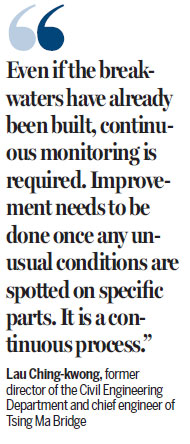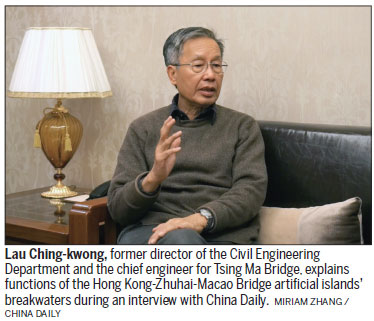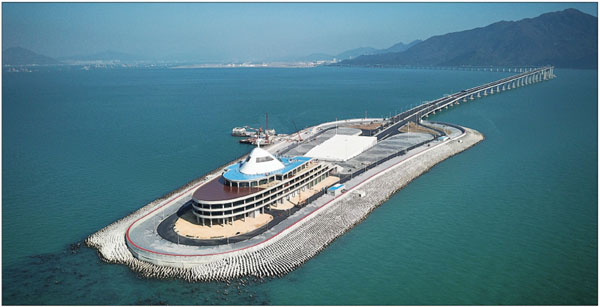Bridge expert clears up doubts over HZMB
Updated: 2018-04-14 06:17
(HK Edition)
|
|||||||||
Tsing Ma Bridge chief engineer points out marine construction is a continuous work in progress, and judgments on quality should not be only based on aerial photos
Editor's note: Last week, some drone photos of the east artificial island of the Hong Kong-Zhuhai-Macao Bridge triggered extensive doubts on the quality of the island's breakwaters dolosse. Some media speculated that the dolosse had been "washed away" by the seawater or had "collapsed".
The bridge operator HZMB Authority and Hong Kong's Highways Department both made responses subsequently, emphasizing that the bridge had passed all checks and had no quality issues as reported by the media. However, voices of doubt haven't faded away. Regarding the incident, China Daily had an exclusive interview with Lau Ching-kwong, a prominent bridge expert in Hong Kong, who's former director of the Civil Engineering Department and the chief engineer of Tsing Ma Bridge, the world's longest suspension bridge with both rail and road traffic. Lau is also one of the consultants for the HZMB's island and tunnel project.
Q: A single breakwater block of the High Island Reservoir in Hong Kong weighs 25 tons; the ones for HZMB weigh 5 to 8 tons; the dolosse of the Hong Kong port, which is another artificial island of the HZMB close to the controversial one, weigh only 2 tons. What are the main considerations for the weight of breakwater structures and why are these design differences there?

Lau Ching-kwong: The use of breakwater blocks, as the HZMB Authority has said, is to protect and eliminate waves and prevent ships from accidentally colliding with the immersed tunnel. High Island Reservoir in Hong Kong faces the Pacific Ocean, where much greater waves hit every day. The HZMB, which is located in Lingding Bay, is not directly facing the Pacific Ocean. Therefore, the wind and waves it encounters are relatively weaker. The situation is quite different and not comparable.
Usually the external forces that a sea construction faces are proportional to the weight of the dolosse. But you can't simply say that the external force the High Island Reservoir faces is five times that of the HZMB. The shape and arrangement (density, height, slope etc.) of the dolosse both have an impact on the protection capability of the breakwaters.
The weight of 5 tons is a choice after comprehensively considering the design requirements, marine environment and construction cost. In the past, there were no marine projects in the sea area where the HZMB is located so only limited data on marine conditions can be accessed.
Therefore, even if the breakwaters have already been built, continuous monitoring is required. Improvement needs to be done once any unusual conditions are spotted on specific parts. It is a continuous process.
These prefabricated pieces might not be placed in the best position at first. The wind and the ocean current change every day, it is quite normal to adjust if there is any mis-position or errors. It's normal in engineering. It is also the way of doing it in Hong Kong as well.
Q: According to the HZMB Authority and Highways Department in Hong Kong, the dolosse of the artificial island weren't washed away by seawater, but were designed to be placed "irregularly" to protect the artificial island as well as the submerged tunnel. The submerged breakwater design will also lower the risk of ship collisions, according to the HZMB Authority. Is it a common design in Hong Kong's civil engineering?
Lau: It is the designer's point of view. He thinks this could provide another safeguard to the tunnel and the island. It is not a bad idea from the perspective of civil engineering.
Q: You could see the irregularly placed breakwater blocks in some online pictures that were shown by the media but invisible in some others. Is it the visual difference caused by the tide?
Lau: Fluctuation of tide is a factor. I believe they were visual differences. The sunlight, the angle and time of pictures being taken could also cause differences. It is unreasonable to judge whether there is a problem with the breakwaters only from aerial photos far away.
Q: The design life of the HZMB is 120 years. But some experts questioned that these breakwaters blocks couldn't meet the requirement. What's your view on that?
Lau: The construction of breakwater blocks falls into marine engineering. The design lifespan of marine engineering is 50 years. You could refer to the "Port Works Design Manual - Marine Works - 50 Years Design Life" in Civil Engineering Office on the Hong Kong Civil Engineering and Development Department website.
Yes the design life of HZMB is 120 years. However, it refers to the lifespan of principal structures of the bridge, such as the body of the tunnel, bridge and the islands.
When it comes to the breakwaters of the artificial island or the protective fence on the bridge, they are affiliated structures, which require regular maintenance work or even replacement. This won't affect the overall lifespan of the entire project.
Q: Some people questioned that the actual arrangement of the breakwaters was different from the artist's impressions or the design sketch. How do you see this?
Lau: It is not easy to place these breakwater blocks. They are quite heavy while the ocean current constantly changes. It is quite difficult to keep them 100 percent the same as the construction design. To be honest, how could you possibly say that the breakwaters are different from design simply based on some photographs?
As the HZMB Authority has said, they placed 14 pieces of dolosse every 25 square meters - that is the standard. Differences must exist between the actual arrangement and the design drawing. Even if some dolosse are washed away by seawater, you just fill some new ones in the place. Then when the next storm comes, the breakwaters will stay fine.
Q: The authority said the fact that the bridge was fine after the attack of Typhoon Hato last year was a proof of the breakwaters' good quality. Do you think it's reasonable to use Hato as a proof?
Lau: I can't jump to the conclusion without having the design manual or the meteorological data of Hato. But judging by the condition of the bridge after Hato, it is acceptable to say the design of the breakwaters withstood the attack.
However, this won't be a 100 percent guarantee that future super-typhoons would not damage the bridge. We have to know that the biggest difference between offshore engineering and land engineering is that the former bears greater risk. Human communities are mostly based on land thus more comprehensive and precise data of the nature could be collected. If you look at the examples of storms damaging offshore engineering around the world, such as in the United States, Japan and Thailand, you will understand that a storm is very difficult to predict, even for world-class projects. The best example is the breakwaters at the Fukushima Nuclear Power Plant in Japan.

|
The eastern artifi cial island of the Hong Kong-Zhuhai-Macao Bridge.Photo Provided To China Daily |
(HK Edition 04/14/2018 page5)
